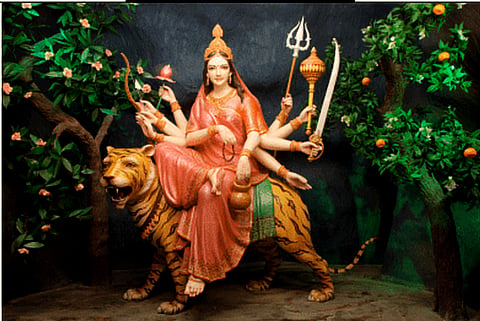
- Home
- न्यूजग्राम
- India
- World
- Politics
- Entertainment
- Culture
- Lifestyle
- Economy
- Sports
- Sp. Coverage
- Misc.
- NewsGram Exclusive
- Jobs / Internships

New Delhi, September 23, 2017: The celebration for Navratri continues for the third day. Tritiya, as it's named suggest the third day is devoted to Maa Chandraghanta, the married form of Goddess Parvati. The ten day long festival of Sharad Navaratri is the celebration of the feminine divine power Goddess Durga.
Maa Chandraghanta, which means "one whose bell is shaped like half-moon" is worshipped with a belief to be free from any ill effects of Shukra (Venue), one of the nine planets. Shukra is believed to be the controller of our sense organs and empower us to achieve name and fame.
In the religious manuscript the goddess is represented with the deity mounting over a tigress. Chandraghanta is portrayed with ten hands with each carrying mace, trishul (trident), sword, water pot, bow, arrow, rosary, and two hands with the blessing posture of Varadamudra and Abhayamudra. She has her third eye, always open, which symbolise her to be ever ready for war against the evil.
People worship her to get rewarded with her grace, and courage. It is believed that with her grace the evil doing, sins, physical and mental suffering are all destroyed.
When we come to the legend of our Hindu God and Goddess, the tales are never ending. A story tells that Lord shiva, the destroyer, promised Parvati that he will not marry any woman. However, Parvati's devotion overwhelmed Lord Shiva and so, he agrees to marry her. On the day of their marriage, Shiva march along with other Gods, mortals, ghost, Aghoris, ghouls and Shivaganas to King Himavan's Palace to take away his daughter, Parvati. The terrorized form of Shiva traumatized Parvati's mother. This is when Parvati transform into Goddess Chandraghanta to protect her parents.
Chandraghanta persuaded Lord Shiva to reappear in his original form. Shiva appeared as a prince ornamented with jewels, and soon Parvati and Lord Shiva gets married.
The day starts with early morning prayers where devotees chant mantra 'Om Ayam hreem Chandraghantaya namah' to worship Maa Chandraghanta. Later, an offering of Goddess favourite jasmine flowers, sindoor (vermilion), kheer (sweet rice), and cow milk is made, followed by prayers to Lord Shiva.
The festival holds immense importance in Hinduism. It is believed from the tales that during the festival, Goddess Durga descends on earth to bless her devotees with happiness and prosperity and bring an end to the evil.
Devotees believe that by fasting for all nine days can bring a change to their physical life and also make their wishes come true.
– Prepared by Abhishek Biswas of NewsGram Twitter: @Writing_desire
